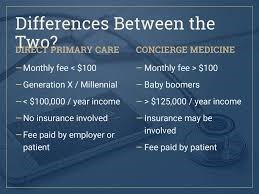Medical & Healthcare
Research Methodology
- Continued growth of Telehealth and Privacy concerns
- Rise Of The Nurse Navigator
- Difference between direct primary care and concierge medicine
- Stem Cell Technology
- Multiple Chronic Condition Research Network
- Wearables Support Bedside Care and Remote Patient Monitoring
- Telehealth Platform Enable Secure Connections from Anywhere
- Mobile Workstations offer more Seamless Care
- Quality Assurance in Nursing
- Decentralized Approach to Care Management
- New Insights into Complex Role of Mitochondria in Parkinson’s disease
Difference Between Direct Primary care and Concierge Medicine
Healthcare can be provided in a number of different forms. The traditional autonomous primary care physician model, in which physicians see a vast number of patients every day and bill insurance companies for their services, is undergoing a transformation. Concierge practises bill offered services by the patient’s insurance company, while DPC practises often rely only on membership fees to cover costs. Membership fees have exclusive access to physicians of all versions. When a practitioner’s practise isn’t fully covered by government reimbursements, the number of cases seen each day is reduced, allowing the doctor to spend more time with each case[1].
The concierge model may have somewhat higher monthly rates, but patients may have greater access to their physician’s services. Concierge practises that see Medicare patients or bill health insurers in addition to the subscription fee are subject to the relevant laws and regulations. DPC models that do not charge premiums are exempt from Medicare and benefits rules. The DPC model, on the other hand, is classified as an acceptable non-insurance option in the Affordable Care Act. In both styles, patients appreciate the individualised attention and contact they receive from their doctors. Physicians will be able to focus solely on patient care because they are not concerned with practise management issues. An individual practitioner must weigh all of the advantages and risks for both the practise and the patient before choosing to turn to either style[2].

Fig3. Difference between direct primary care and concierge medicine[1]
